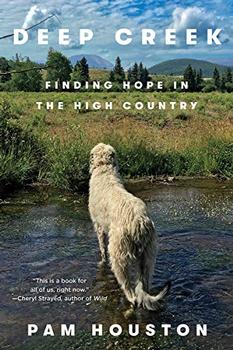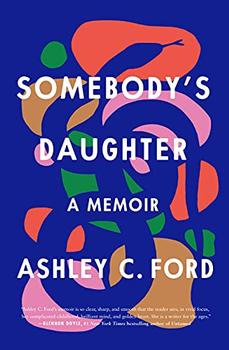Summary | Excerpt | Reviews | Beyond the book | Read-Alikes | Genres & Themes | Author Bio

Finding Hope in the High Country
by Pam HoustonMany of us have a safe place to call home. For most, home is somewhat close to family, friends, a community, or a job. It took author and essayist Pam Houston until she was in her thirties to find her home, and she didn't choose it to be close to work or family. A four hour drive from the Denver airport, nestled among rivers and mountain peaks, Houston's 120-acre ranch is both the setting and the focus of her memoir, Deep Creek: Finding Hope in the High Country.
The book unfolds in the form of personal essays. Some of these recall the events of the author's childhood, during which she was neglected by her mother and violently and sexually abused by her father. As we learn the details of her early life, we come to understand how and why her ranch has become her sanctuary. Each essay is followed by short, italicized "ranch almanac" entries that anchor the memoir to its setting and detail the finer points of ranch management, such as the importance of finding high-quality hay, or how to saw off a ram's inward-growing horns with burning metal.
Houston has relationships with friends, fellow writers, students and the residents of the small Colorado town of Creede – but the main characters in her memoir aren't the people. Instead, her story centers around the animals on her ranch, both resident and wild; the history of the acreage in its structures and ghosts; and the trees, flowers and contours that make up the landscape. At one point she mentions a handful of books that had "shaped [her] sensibility as a young writer." Among them are Annie Dillard's Pilgrim at Tinker Creek and Aldo Leopold's A Sand County Almanac. Echoes of those works are evident in Houston's awe of the natural world and her stewardship of the land. She says, "right from the beginning I've felt responsible for these 120 acres, and for years I've painted myself both savior and protector of this tiny parcel of the American West."
Her longest essay, "Diary of a Fire," spans mid-June through July 2013, when one of the largest wildfires in Colorado history was sparked by lightning that struck 15 miles from Houston's ranch (see Beyond the Book). In this essay, she relays the fire reports, and learns – and teaches us – the USDA Forest Service terminology. Weather reports and memos from online emergency bulletins gain new urgency as she carefully watches temperature, relative humidity, precipitation and wind speed readings, holding onto the hope that the rivers, the aspens, or the continental divide would somehow protect her ranch. As she writes the check for her final mortgage payment, she wonders about the irony, noting "the fire [was] still burning a half mile from my kitchen."
The details of ranch life are firmly in the foreground of Houston's memoir – whether in descriptions of native wildflowers or how she navigates to fill horse troughs during a winter storm. But the recurring theme of climate change is ever present as well, both as a wider political concern and as private grief. Houston's writing seems to be part of her answer to these anxieties:
As we hurtle toward the cliff, foot heavy on the throttle, to write a poem about the loveliness of a newly leafed out aspen grove or a hot August wind sweeping across prairie grass or the small of the air after a three-day rain in the maple forest might be at best so unconscionably naïve, and at worst so much part of the problem, we might as well drive a Hummer and start voting Republican.
Maybe. But then again, maybe not. Maybe this is the best time there has ever been to write unironic odes to nature.
The one critique I had reading the first part of the book was that it was hard to track the various ranch sitters and friends who came and went throughout the essays. I'd find myself stopping and restarting the new section to get my bearings. But I also thought Houston's voice more than compensated with its grace. I've read other stories from daring women who venture out, take on the world, and "find themselves" along the way. Too often, I feel chastised. When I get to the end, I'm left with the feeling that I am somehow "not enough" – whether that means I'm not daring enough, not healthy enough, or not environmentally-conscious enough. Houston's memoir did not affect me this way; she writes with a humility that is plain, arresting and beautiful.
Houston considers large and vexing questions that stem from climate change: "Would I give up my life to save the earth?" Her answers weave in and out of her essays, mostly as the physical details that move her toward gratitude and awe. She details the seasonal cycles and the smell and discoloration of the forest along the burn line. She shows passion for the living and grieves the creatures she can no longer protect. Facing climate change, she doesn't focus on anger or blame. She looks ahead to a renewal that comes, suddenly, in new shoots of green grass.
Further Reading: Essays by Pam Houston
![]() This review was originally published in The BookBrowse Review in February 2019, and has been updated for the
January 2020 edition.
Click here to go to this issue.
This review was originally published in The BookBrowse Review in February 2019, and has been updated for the
January 2020 edition.
Click here to go to this issue.

If you liked Deep Creek, try these:

by Anne Lamott
Published 2024
From the bestselling author of Dusk, Night, Dawn and Help, Thanks, Wow, a joyful celebration of love

by Ashley C. Ford
Published 2022
One of the most prominent voices of her generation debuts with an extraordinarily powerful memoir: the story of a childhood defined by the looming absence of her incarcerated father.
Your guide toexceptional books
BookBrowse seeks out and recommends the best in contemporary fiction and nonfiction—books that not only engage and entertain but also deepen our understanding of ourselves and the world around us.